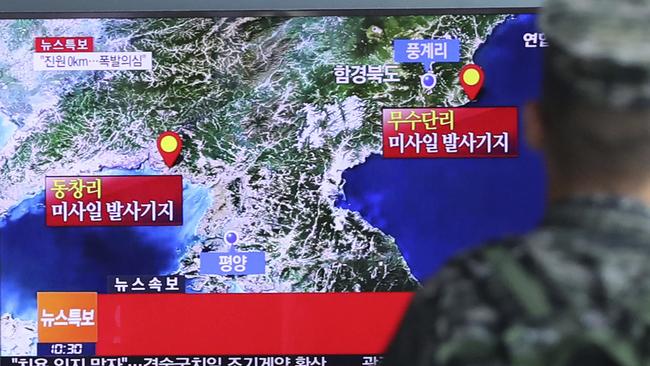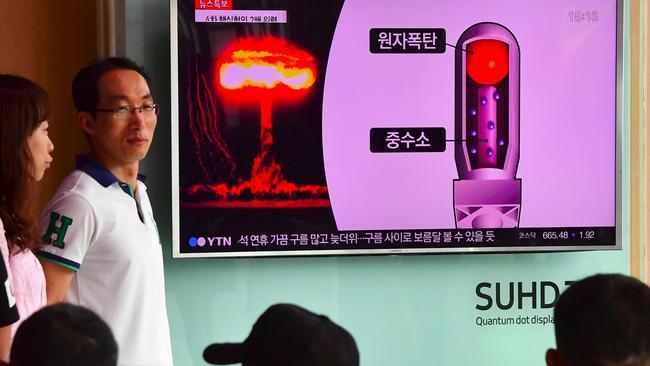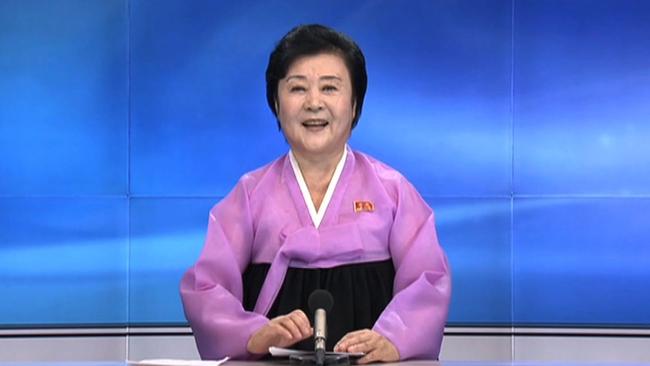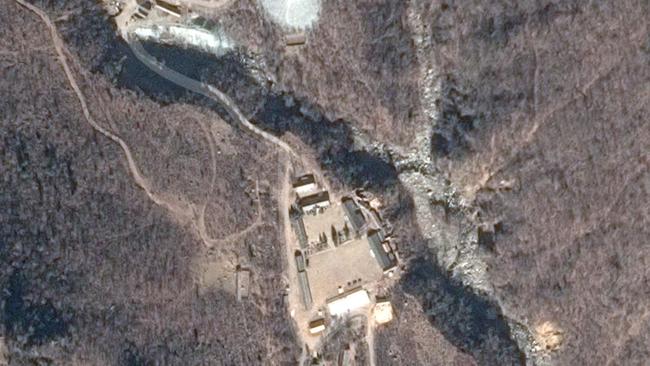5.3-magnitude seismic event reported close to North Korean nuclear test site
MALCOLM Turnbull has added his voice to the chorus of condemnation levelled at North Korea for its 10-kiloton nuclear warhead test.

PRIME Minister Malcolm Turnbull has condemned North Korea’s decision to detonate its largest ever nuclear warhead as “reckless” and “dangerous”.
Earlier, South Korea’s President labelled the test as “maniacal”.
Speaking from Micronesia, where he is at a meeting of the Pacific Islands Forum, Mr Turnbull laid into Pyongyang.
“The recklessness, described quite appropriately by President Park Geun-hye of South Korea as ‘maniacal’, the recklessness of North Korea puts the world’s peace at risk. It’s persistence, it’s provocative, it’s dangerous,” he said.
Mr Turnbull called on “all the nations of the world” to enforce sanctions on North Korea.
In London, Foreign Minister Julie Bishop said, “While North Korea is testing nuclear weapons ... the long-suffering people need a regime that focuses on their needs, not provocative behaviour that represents a global and regional threat.”
On Friday afternoon, Pyongyang confirmed it had conducted its fifth nuclear test, hours after seismic monitors detected a blast near the regime’s nuclear test site.
Just last monththe communist regime warned it would turn the US and South Korean capitals into “heaps of ash”.
North Korean state TV said the country is now capable of mounting nuclear warheads on ballistic rockets, reported Reuters. If the claim is true, and the secretive state is known for self-aggrandisement, it will worry Washington who know they are top of the target list.
US President Barack Obama was informed of the test while onboard Air Force One as he returned to America from the ASEAN conference in Laos.
A spokesman said Obama indicated he would consult America’s allies in the days ahead “to ensure provocative actions from North Korea are met with serious consequences.”
China, normally a staunch ally of the closed country, has also chastised Pyongyang.
The Foreign Ministry issued a statement on Friday criticising North Korea for carrying out a test with “disregard” for international objections.
A “seismic event” had been reported at 9:30am local time with South Korean officials saying there was a “high possibility” it was a test of a 10-kiloton nuclear weapon. If so, it would be far larger than the 6-9 kiloton bomb tested in January.

According to US Geological Survey (USGS), the 5.3-magnitude event occurred 18km east-northeast of Sungjibaegamin in the country’s north putting it close to the Punggye-ri weapons testing facility.
The USGS said the event was at “zero depth”, while naturally occurring earthquakes strike below ground, not on the surface.
On Friday, South Korean President Park Geun-hye strongly condemned the test and North Korean dictator Kim Jong Un, saying in a statement that it showed the “maniacal recklessness of the Kim Jong Un government as it clings to a nuclear development”.

Seoul, the capital of the South, is just 60 kilometres from the border between the two Koreas.
There have been reports the isolated nation had been preparing for a fifth nuclear test. Recent activity around the site indicated an explosion was imminent.
North Korea tests its nuclear arsenal deep inside Mount Mant’ap close to Punggye-ri.
Friday is North Korea’s National Day, an opportunity the county often uses to demonstrate its military might.
Pyongyang said the test had, “finally examined and confirmed the structure and specific features of movement of (a) nuclear warhead that has been standardised to be able to be mounted on strategic ballistic rockets.
“The standardisation of the nuclear warhead will enable (North Korea) to produce at will and as many as it wants a variety of smaller, lighter and diversified nuclear warheads of higher strike power,” the country said.
“The 10-kiloton blast was nearly twice the fourth nuclear test and slightly less than the Hiroshima bombing, which was measured about 15 kilotons,” said Kim Nam-Wook from the South’s meteorological agency said.

Japan’s public broadcaster NHK reported the country’s defence ministry was preparing to dispatch aircraft to analyse air samples to see if any radiation could be detected.
“If North Korea conducted a nuclear test, that can never be tolerated. We must lodge a strong protest,” said Prime Minister Abe.
“We need to make them understand North Korea will be further isolated from the international community if they continue with nuclear tests and ballistic missile launches,” he said at the ASEAN regional conference in Laos.
In August, Pyongyang issued a fresh warning to Seoul and Washington, threatening a huge nuclear attack if provoked.
The North’s military warned it will turn the cities into “a heap of ash through a Korean-style pre-emptive nuclear strike” if they show any signs of aggression towards their territory, a spokesman for North Korea’s military was quoted as saying by the country’s state media.
A second nuclear test this year would be a defiant response to Western pressure on Pyongyang to halt its nuclear ambitions.
Any test will lead to a strong push for new, tougher sanctions at the United Nations and further worsen already abysmal relations between Pyongyang and its neighbours. North Korean nuclear tests worry outside governments because they are seen as moving North Korea’s scientists and engineers that much closer to their goal of an arsenal of nuclear-tipped missiles that can reach the US.

North Korea is thought to have a handful of rudimentary nuclear bombs and has spent decades trying to perfect a multistage, long-range missile to eventually carry smaller versions of those bombs. After several failures, it put its first satellite into space with a long-range rocket launched in December 2012, and has since launched another such successful launch.
Experts say that ballistic missiles and rockets in satellite launches share similar bodies, engines and other technology. The UN calls the North’s long-range rocket launches banned tests of ballistic missile technology.

Some analysts say the North hasn’t likely achieved the technology needed to manufacture a miniaturised nuclear warhead that could fit on a long-range missile. But there is a growing debate on just how far the North has advanced in its secretive nuclear and missile programs.
— Additional reporting by Tory Shepherd



